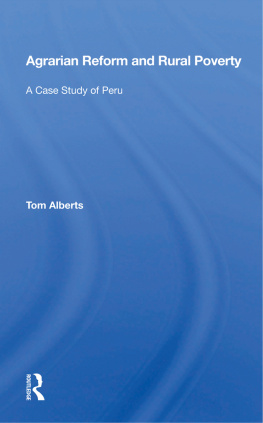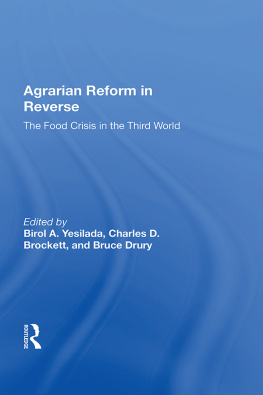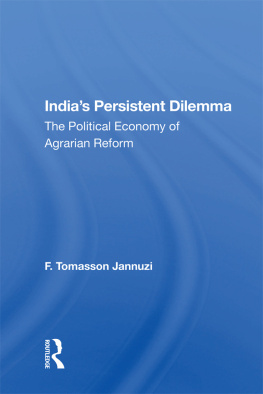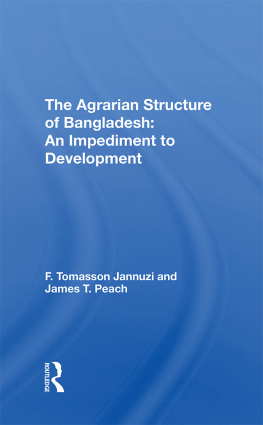Agrarian Reform and Rural Poverty
Westview Replica Editions
The concept of Westview Replica Editions is a response to the continuing crisis in academic and informational publishing. Library budgets for books have been severely curtailed. Ever larger portions of general library budgets are being diverted from the purchase of books and used for data banks, computers, micromedia, and other methods of information retrieval. Interlibrary loan structures further reduce the edition sizes required to satisfy the needs of the scholarly community. Economic pressures on the university presses and the few private scholarly publishing companies have severely limited the capacity of the industry to properly serve the academic and research communities. As a result, many manuscripts dealing with important subjects, often representing the highest level of scholarship, are no longer economically viable publishing projectsor, if accepted for publication, are typically subject to lead times ranging from one to three years.
Westview Replica Editions are our practical solution to the problem. We accept a manuscript in cameraready form, typed according to our specifications, and move it immediately into the production process. As always, the selection criteria include the importance of the subject, the work's contribution to scholarship, and its insight, originality of thought, and excellence of exposition. The responsibility for editing and proofreading lies with the author or sponsoring institution. We prepare chapter headings and display pages, file for copyright, and obtain Library of Congress Cataloging in Publication Data. A detailed manual contains simple instructions for preparing the final typescript, and our editorial staff is always available to answer questions.
The end result is a book printed on acid-free paper and bound in sturdy library-quality soft covers. We manufacture these books ourselves using equipment that does not require a lengthy make-ready process and that allows us to publish first editions of 300 to 600 copies and to reprint even smaller quantities as needed. Thus, we can produce Replica Editions quickly and can keep even very specialized books in print as long as there is a demand for them.
About the Book and Author
Agrarian Reform and Rural Poverty: A Case Study of Peru
Tom Alberts
Initiated in 1969 after the establishment of Velasco Alvarado's military government, Peru's program for agrarian reform remains one of the few enduring examples of major planned reform in Latin America. Based on extensive data for land ownership, income distribution, and agricultural production, this book assesses Peru's experience with development planning since 1950 and discusses efforts to improve the standard of living of its rural population through changes in agrarian structure.
Dr. Alberts is a consultant for several international development agencies and for the U.N. International Labour Organization.
Agrarian Reform and Rural Poverty
A Case Study of Peru
Tom Alberts
First published 1983 by Westview Press
Published 2018 by Routledge
52 Vanderbilt Avenue, New York, NY 10017
2 Park Square, Milton Park, Abingdon, Oxon OX14 4RN
Routledge is an imprint of the Taylor & Francis Group, an informa business
Copyright 1983 by Taylor & Francis
All rights reserved. No part of this book may be reprinted or reproduced or utilised in any form or by any electronic, mechanical, or other means, now known or hereafter invented, including photocopying and recording, or in any information storage or retrieval system, without permission in writing from the publishers.
Notice:
Product or corporate names may be trademarks or registered trademarks, and are used only for identification and explanation without intent to infringe.
Library of Congress Cataloging in Publication Data
Alberts, Tom, 1943
Agrarian reform and rural poverty.
(Westview replica edition)
Bibliography: p.
1. Land reformPeru. 2. Rural poorPeru. I. Title.
HD1333. P4A4 1983 338.1'885 83-10326
ISBN 13: 978-0-367-02042-2(hbk)
In 1964 I started studying economics, greatly interested in economic and social development. After a few years I was convinced that the rural sector and agriculture were central to overall growth and development. I also felt it necessary to acquire first hand knowledge of developing countries. When an opportunity became available to work for the UN in Peru in 1968, I accepted the offer and arrived in December of that year in Lima. President Belaunde had just been overthrown by a military coup and the new military government promised sweeping reforms. Very few people believed that these promises were more than rhetoric.
While I worked in Peru in 1968-1971, mainly in agricultural planning, I often wanted to sit down to reflect and analyze the rapid events which took place. The very interesting years in Peru were followed by three more years in Chile with its equally important social changes, not least in the agricultural sector. Even my work in development since has convinced me that many governments in developing countries are preoccupied first with modernization and industrialization. Rural development seems to be generally neglected in domestic economic planning for developing countries.
I have been writing this book on Peru since 1975. It was first published in 1981 in a limited edition. This is a slightly modified version of the work; the worst errors have been corrected and the bibliography has been updated to include several important Peruvian publications.
Unfortunately the main conclusions remain valid. Agriculture continues to be the major bottleneck for social and economic development in Peru, While there has been a slight growth in overall per capita output between 1970 and 1983, income distribution has deteriorated and value-added in agriculture has declined significantly on a per capita basis. Although agricultural exports were significantly higher than imports at the end of the 60s, imports took the lead at the beginning of the 80s. In 1978, Peru negotiated an agreement with the IMF and a debt relief programme was agreed upon by both the Paris Club and commercial banks. Still, in March 1983, Peru was following other Latin American countries by defaulting on foreign debt repayments. I predict that as the world economy starts to grow during 1983, Peru will soon be pulled out of the most pressing problems. It will then be possible to continue to neglect Peruvian agriculture.
Rural poverty continues to be a serious problem. Twenty years after the rural guerilla movements of the 60s, they are reoccurring. The answer has always been repression. My hope, though, is that the Peruvian peasant will be given a fair chance to participate in future development, through increased economic interest in rural areas.
Tom Alberts
Simrishamn
5 April 1983
1
Introduction
Uneven distribution of incomes and wealth is a characteristic of most Third World countries. Since the majority of the people live in rural areas, agrarian reform could help to equalize incomes and wealth, as well as to increase agricultural growth.
Peru is an important country in the discussion of agrarian reform. In October 1968 a military junta took power in Peru. Its main development objectives were, "... to accelerate the rate of economic growth, redistribute the income...[and to] assure the incorporation of the Peruvians, of all regions of the country, in the benefits of progress."' One of the key elements in the development strategy of the military junta was an agrarian reform. This is a case study of the Peruvian agrarian reform as a strategy to improve the standard of living of the rural population. It investigates to what extent the government was successful in accomplishing the objectives of redistribution and growth.







